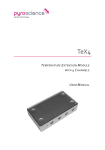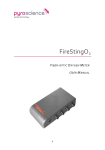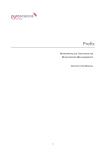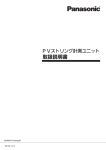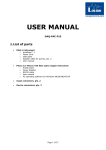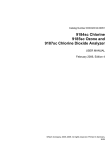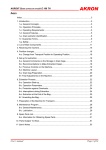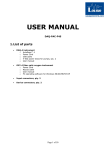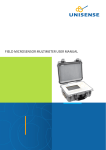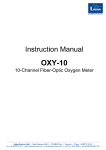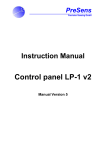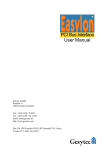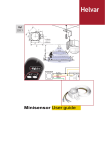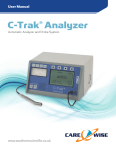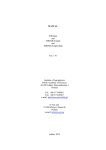Download Firesting O2 - Pyro Science
Transcript
FireSting O2 F IBEROPTIC O XYGEN M ETER U SER M ANUAL Document Version 2.04 Refers to FireSting Logger Software version >2.35 The FireSting O2 is manufactured by PyroScience GmbH Hubertusstr. 35 52064 Aachen Germany Phone Fax Email Internet +49 (0)241 4004 555 +49 (0)241 4004 558 [email protected] www.pyro-science.com Registered: Aachen HRB 17329, Germany ii T ABLE OF C ONTENT 1 OVERVIEW .............................................................................. 1 2 SAFETY GUIDELINES ............................................................... 3 3 INTRODUCTION TO THE FIRESTING O2 ................................... 6 4 SOFTWARE INSTALLATION .................................................... 8 5 OXYGEN SENSOR TYPES........................................................ 9 5.1 5.2 5.3 5.4 5.5 5.6 5.7 6 NEEDLE-TYPE SENSORS.............................................................. 9 BARE FIBER SENSORS ............................................................... 12 SENSOR SPOTS........................................................................ 13 SENSOR CUVETTES................................................................... 15 FLOW-THROUGH CELLS ............................................................ 15 ROBUST MINIPROBE ................................................................. 16 CONNECTING THE SENSORS ....................................................... 16 THE SOFTWARE “FIRESTING LOGGER” .................................. 18 6.1 MAIN WINDOW........................................................................ 18 6.2 SETTINGS................................................................................ 25 6.2.1 Basic Settings .................................................................... 27 6.2.2 Advanced Settings ............................................................. 27 6.2.3 Environmental Conditions .................................................. 29 6.2.4 Temperature Settings ........................................................ 30 6.2.5 Optional Settings .............................................................. 31 6.3 TEMPERATURE PANEL............................................................... 32 6.4 OVERVIEW PANEL .................................................................... 33 6.5 THE RAW DATA WINDOW.......................................................... 33 7 CALIBRATION PROCEDURE ................................................... 35 7.1 7.2 7.3 7.4 7.5 FACTORY CALIBRATION ............................................................. 36 THE 1-POINT CALIBRATION........................................................ 36 THE 2-POINT CALIBRATION ....................................................... 38 ADVANCED CALIBRATION .......................................................... 40 BACKGROUND COMPENSATION OF CONTACTLESS SENSORS ........... 42 iii 8 CALIBRATION STANDARDS ................................................... 43 8.1 THE 100% STANDARD .............................................................. 43 8.1.1 Water-Vapor Saturated Air ................................................ 43 8.1.2 Ambient Air ....................................................................... 43 8.1.3 Air-Saturated Water .......................................................... 44 8.2 THE 0% STANDARD.................................................................. 44 8.2.1 Water Flushed with Nitrogen Gas ....................................... 44 8.2.2 Water Mixed with a Strong Reductant ................................ 45 8.2.3 Nitrogen Gas ..................................................................... 45 9 CALIBRATION OF CONTACTLESS SENSORS ..........................46 9.1 9.2 10 CALIBRATION PROCEDURE ......................................................... 46 BACKGROUND COMPENSATION .................................................. 46 TEMPERATURE MEASUREMENT............................................49 10.1 10.2 AVAILABLE TEMPERATURE SENSORS ........................................... 49 AUTOMATIC TEMPERATURE COMPENSATION ................................ 49 11 SPECIFICATIONS OF THE FIRESTING O2 ................................. 51 12 SENSOR SPECIFICATIONS ..................................................... 52 12.1 12.2 12.3 12.4 12.5 12.6 12.7 12.8 13 MEASURING RANGE.................................................................. 52 AVAILABLE SENSOR DIMENSIONS ............................................... 53 POSSIBLE CALIBRATION MODES ................................................. 53 DETECTION LIMIT AND RESOLUTION ........................................... 54 ACCURACY .............................................................................. 55 RESPONSE TIME....................................................................... 56 LONG-TERM DRIFT ................................................................... 57 TYPICAL VALUES FOR ADVANCED SETTINGS ................................. 57 APPENDIX ............................................................................. 58 13.1 13.2 13.3 13.4 13.5 13.6 TROUBLESHOOTING ................................................................. 58 MEASURING PRINCIPLE ............................................................. 59 OPERATING SEVERAL FIRESTING O2 IN PARALLEL .......................... 61 DEFINITION OF OXYGEN UNITS................................................... 62 TABLE OF OXYGEN SOLUBILITY .................................................. 64 EXPLANATION OF THE SENSOR CODE .......................................... 66 iv 1 Overview The compact PC-based fiber-optic oxygen meter FireSting O2 with 1, 2 or 4 channels unifies several innovative technological improvements making it the new standard of high precision oxygen sensing with fiber-optical oxygen sensors (optodes). The FireSting O2 utilizes a new unique measuring principle based on red light excitation and lifetime detection in the near infrared using novel luminescent oxygen indicators (REDFLASH technology, see Appendix 13.2 for more details). It is a multipurpose oxygen meter • • working with oxygen needle-type (retractable, fixed), bare fiber and contactless sensors (sensor spots, sensor cuvettes and flow-through cells), as well as robust miniprobes and working with full range and trace oxygen sensors. Along with the FireSting O2 we offer a variety of fiber-optical oxygen sensors, differing in tip diameter, tip geometry and measuring concentration range, which can be adjusted at your needs. Furthermore, we also offer turnkey motorized microprofiling setups enabling the measurement of depth-profiles of oxygen concentration in environmental samples at high temporal and spatial resolution. The FireSting O2 enables a diverse range of applications for measuring oxygen at different concentration ranges, sample types and spatial scales. This multipurpose oxygen meter allows measurements with microsensors in small samples and detection of depth-resolved oxygen microgradients in semi-solid samples like sediments, biofilms, or tissue. With the same oxygen meter it is also possible to monitor oxygen concentrations in air or aquatic environments using minisensors, robust miniprobes or sensor spots for long-term measurements. 1 Our consulting service is available to inform you about the new and outstanding FireSting O2, different sophisticated sensor types, microprofiling setups from PyroScience, their applicability and integration into existent devices as OEM solution. More information concerning our products can be found at www.pyro-science.com or contact us under [email protected] We would be pleased to serve you concerning all needs for sensing oxygen at high precision and resolution with state-of-the-art technology. Profit from our innovation, scientific expert knowledge and flexibility to develop customized solutions for high performance sensing technology. Your PyroScience Team 2 2 Safety Guidelines The FireSting O2 is a laboratory instrument to be used with fiberoptic oxygen sensors (optodes) from PyroScience for measuring oxygen at high precision and resolution. In order to guarantee an optimal performance of the FireSting O2 please follow these operation instructions and safety guidelines. Before starting a measurement with the FireSting O2 please allow for an appropriate installation of the FireSting Logger software before plugging the FireSting O2 for the first time into a USB-port of your PC ambient temperature, cleanness and humidity, connection of sensors and products (extension module) supplied from PyroScience, calibration of the sensors, precaution during handling of the needle-type sensors to avoid injuries or breaking of the sensor and functioning of the FireSting O2. If any problems or damage evolve, please disconnect the instrument immediately, mark it to prevent any further use and consult PyroScience for repair or maintenance service. The FireSting O2 should not be manipulated or opened by unauthorized persons, only by PyroScience or persons advised directly from PyroScience. Please note that opening the housing will void the warranty. There are no serviceable parts inside the device. The FireSting O2 and sensors should be kept and stored outside the reach of children in a secure place under dry and clean conditions at room temperature, avoiding moisture, dust, corrosive conditions and heating of the instrument. This device is 3 not intended for medical, military or other safety relevant areas. It should be used in the laboratory by qualified personal only following the operation instructions and safety guidelines of this manual. Please follow the appropriate laws and guidelines for safety like EEC directives for protective labor legislation, national protective labor legislation, safety regulations for accident prevention and safety data-sheets from manufacturer of chemicals used during measurements. Calibration of the sensors, data acquisition, data processing and data publication is on the user's authority. When used in the field, the environmental conditions (like high humidity, dust, exposure to direct solar radiation) may cause damage or interference of the FireSting O2, which is on the user's authority. 4 Before using the Firesting O2 and its sensors, read carefully the instructions and user manuals for the oxygen meter Firesting O2. In case of problems or damage, disconnect the instrument and mark it to prevent any further use! Consult Pyro Science for advice! There are no serviceable parts inside the device. Please note that opening the housing will void the warranty! The Firesting O2 is not watertight, is sensitive to corrosive conditions and to changes in temperature causing condensation. Avoid any condition (e.g. direct sun light) causing a heating of the device above 50°C (122°F). Handle the sensors with care especially after removal of the protective cap! Prevent mechanical stress to the fragile sensing tip! Avoid strong bending of the fiber cable! Prevent injuries with needle-type sensors! Calibration and application of the sensors is on the user’s authority, as well as data acquisition, treatment and publication! The sensors and the oxygen meter Firesting O2 are not intended for medical or military purposes or any other safety-critical applications. The sensors should be used in the laboratory only by qualified personal following the user instructions and the safety guidelines of the manual, as well as the appropriate laws and guidelines for safety in the laboratory! Keep the sensors and the oxygen meter Firesting O2 outside the reach of children! 5 3 Introduction to the FireSting O2 The FireSting O2 is a multipurpose oxygen meter that is compatible with all available oxygen sensors from PyroScience (needle-type, bare fiber and contactless sensors, miniprobes). Most sensors are available for the full range (0-100% O2) and for the trace range (0-21% O2). The optical detection technology is based on the unique oxygen-sensitive REDFLASH indicators which use red light excitation and lifetime detection in the near infrared (see Appendix 13.2 for more details). The oxygen-sensitive REDFLASH indicators show excellent brightness and their red light excitation significantly reduces stress in biological systems and interferences caused by autofluorescence. The FireSting O2 is a high precision, compact PC-based fiber-optic oxygen meter with 1, 2 or 4 channels for measurements in the laboratory. Additionally, one temperature sensor can be connected allowing for automatic temperature compensation of the oxygen measurement. The FireSting O2 is operated via an USB connection to a PC with a Windows operation system. The included logging software FireSting Logger provides comfortable calibration and logging functionality. The FireSting O2 can be used in various environments, but is designed as a laboratory instrument. If used in the field, please protect the FireSting O2 from heating, moisture and corrosion. 6 The FireSting O2 comes with 1, 2, or 4 channels (connectors S1 to S4) on the right side panel for up to 4 fiber-optic oxygen sensors and one connector (T) for a temperature sensor. The USBconnector on the left side panel provides the energy supply and the data exchange with the PC. 7 4 Software Installation System requirements: PC with Windows XP/Vista/7 (but not "Windows 7 Starter Edition") and min. 200 MB free disk space. IMPORTANT: Do not connect the FireSting O2 to your PC before the FireSting Logger software has been installed. The software will install automatically the appropriate USB-drivers. Installation steps: • download the installer package for the newest version of the FireSting Logger software from the PyroScience homepage: www.pyro-science.com/downloads.html • unzip and start the installer and follow the instructions • connect the FireSting O2 with the USB-cable to the computer. The red logo will flash shortly indicating the correct startup of the oxygen meter. After the successful installation a new program group „Pyro FireSting O2“ is added to the start menu, and a short-cut named "FireSting" can be found on the desktop. Remark to “Windows 7 Starter Edition”: Some laptops or netbooks are delivered only with a limited Windows version called “Windows 7 Starter Edition”, which does not support the FireSting O2. In that case you should look in the Windows system settings for “Windows Anytime Upgrade”. Here you can purchase and download online an upgrade to a full Windows version. 8 5 Oxygen Sensor Types 5.1 Needle-Type Sensors The needle-type oxygen sensors are composed of a fiber-optical cable (C; 2.5 m standard length) with a plug (P) for connection to the FireSting O2 meter, a metal housing (H, fixed or retractable), and a syringe needle (N; 40 mm standard length) including the fiber with a fragile sensing tip. On each sensor, a specific Sensor Code (SC) is attached to the cable. At the tip of the sensors (T), the oxygen-sensitive REDFLASH indicator is immobilized in a raisin. The needle-type oxygen sensors are offered with different tip diameters, including microsensors with a tapered sensor tip of ca. 40-60 µm in diameter (A) and minisensors with a flat sensor tip (B) of 230 µm, 430 µm, 0.5 mm and 1.1 mm in diameter. 9 The sensor tip can be retractable (R) or fixed (F) in the housing. Microsensor (retractable) Minisensor (fixed) The retractable sensor tip allows sensor insertion through septa, package material or tissue and subsequent extension of the sensor tip into the sample for oxygen measurements. The retractable sensors are available as microsensors (40-60 µm) and as minisensors (230 µm, 430 µm). The sensors are shipped in position 0 (retracted position) to protect the tip from breaking. The needle is covered with a protective cap (PC), which has to be removed carefully before using the sensor. After removal of the protective cap from the needle, the sensor should be fixed in a stable set-up like a solid laboratory stand or a micromanipulator mounted on a heavy stand from PyroScience. In case of retractable sensors, move gently the push-button (PB) from the retracted position 0 to the extended positions 1 (tip flush with needle tip), 2 or 3, thereby moving the sensor tip ca. 6 mm (position 2) or 12 mm (position 3) out of the needle into the water or gas phase of the sample. Please take care when handling the needle-type sensors to prevent injuries and breaking of the sensor. Ensure enough space in front of the fragile sensor tip, especially when pushing it out! 10 The needle-type microsensors are appropriate for high resolution measurements in semi-solid samples, like sediments, biofilms or tissues with PyroScience turnkey motorized microprofiling setups. They allow measurements in small sample volumes, along steep gradients and of depth-resolved oxygen profiles at high spatial resolution. Please always use a stable stand and a micromanipulator to move the sensor into a semisolid sample like sediment, biofilm, tissue. The minisensors are standard sensors for robust long-term oxygen measurements in gaseous or aquatic environments. Fixed minisensors with a mechanically protected tip (0.5 mm diameter) can be used for insertion through a rubber septum without addition of air to gas samples. Here the very sensor tip is flush with the tip of a beveled needle and glued into it. In case of fixed minisensors with a tip diameter of 1.1 mm, the fixed sensor tip extends 1 mm from the needle tip and is hence unprotected after removal of the protective cap. Avoid any contact to harsh surfaces! 11 The needle-type sensors can be sterilized with ethylene oxide (EtO) and can be cleaned with peroxide (3% H2O2), soap solution or ethanol. They can be applied in gas phases, aqueous solutions, ethanol, methanol and isopropanol. Other organic solvents and gaseous chlorine (Cl2) induce interferences with the sensor reading. No cross-sensitivity was found for pH 1-14, CO2, CH4, H2S and any ionic species. After finalization of the measurements, the sensor tip of the oxygen sensors should be rinsed carefully with demineralized water. In case of retractable sensors, retract the sensor tip and put on the protective cap (PC) onto the needle to protect the sensor. Store the sensor at a dry, dark and secure place. A signal drift of the sensor can indicate photobleaching of the oxygen-sensitive REDFLASH indicator, depending on the intensity of the excitation light and frequency of measurements. The needle-type oxygen sensors are also optionally available with optical isolation for measurements in samples with autofluorescence. With this optical isolation, interferences between the REDFLASH indicator luminescence and autofluorescence, e.g. from photosynthetic pigments, are reduced. However, the optical isolation causes an increase in the response time t90, which is the time for 90% of the total sensor signal change (see chapter 12). 5.2 Bare Fiber Sensors The bare fiber sensors are identical to the retractable needle-type oxygen sensors, except that they do not contain a housing. They comprise only the bare optical fiber with the REDFLASH indicator immobilized on the fragile sensor 12 tip. The bare fiber sensors are available both as microsensors (4060 µm tip diameter) and as minisensors (230 µm, 430 µm tip diameter). They can be used with customized housing with complex geometries or they might be inserted directly into samples ("implantable sensors"). 5.3 Sensor Spots PyroScience offers a range of contactless oxygen sensors, comprising sensor spots, sensor cuvettes and flow-through cells. The sensor spots are coated with the novel REDFLASH indicator with PET foil or glass as carrier material. The sensor spots allow oxygen measurements in closed vessels in combination with the FireSting O2. They have standard diameters of 5 mm or 8 mm and can also be obtained with an optical isolation (black coating). The sensor spots have a rough sensing surface (SF) which is whitish-green and facing towards the paper side of the packaging. The backside (BS) is smooth, shiny BS SF and dark-green. The sensor spots can be glued with their backside on transparent, clean and dry inner container walls (plastic or glass, wall thickness 0-6 mm) using an appropriate adhesive (e.g. transparent silicone based on acetic acid, item no. SPGLUE). After the glue has dried, 13 the gas or liquid sample has to be filled into the container so that the whitish-green sensing surface of the spot is completely covered and in contact with the sample. For containers with wall thicknesses of 0-2 mm, the Basic Spot Adapter (a 10x10x10 mm plastic cube, item no. SPADBAS) needs to be fixed tightly or glued to the outer container wall at the spot position. Then the sensor signal can be read out using the Spot Fiber (item no. SPFIB) connecting the basic spot adapter with the FireSting O2. For measurements through containers with wall thicknesses of 2-6 mm, the metallic Lens Spot Adapter (item no. SPADLNS) with an integrated collimating lens has to be used instead. It comes together with a flexible re-adjustable cable binder for quick positioning of spot adapters e.g. on laboratory flasks with a maximal diameter of ~10 cm. The spot adapter is then connected with the Spot Fiber to a channel of the FireSting O2. It is important to fix or glue the spot adapter firmly to the outer container wall. The position of the spot adapter should not be changed after calibration of the sensor spot (otherwise the spot has to be re-calibrated). 14 The general characteristics, like cross-sensitivity, optimal and maximal range of measurements, limit of detection, accuracy and resolution, are the same as for the needle-type sensors (see chapter 5.1 and 12). The sensor spots offer a versatile field of application for multisampling measurements and online-monitoring of oxygen at greater scales. This includes the application in e.g. respiration and photosynthesis chambers, bioreactors, growth experiments, studies of enzyme kinetics, cell biological approaches and industrial process water-monitoring, including aqua-farming, sewage treatment and cooling water cycling. 5.4 Sensor Cuvettes The oxygen sensor cuvettes are standard plastic cuvettes (10x10x45 cm) with an oxygen sensor spot glued to one side wall of the cuvette. They allow precise contactless oxygen measurements within the liquid content of the cuvette. A Basic Spot Adapter (item no. SPADBAS) has to be fixed/glued to the outside of the cuvette at the spot position. The spot adapter is then connected with the Spot Fiber (item no. SPFIB) to a channel of the FireSting O2. 5.5 Flow-Through Cells The flow-through cell has an integrated oxygen sensor spot, allowing online-monitoring of the oxygen concentration in a gas or 15 liquid sample pumped through the cell. The flow-through cell can be directly connected with the Spot Fiber (item no. SPFIB) to the FireSting O2. The tubing has an outer/inner diameter of ca. 2/1.5 mm. 5.6 Robust Miniprobe The sensor tips of the robust oxygen miniprobes consist of a stainless steel tubing 3 mm in diameter, and 3 or 10 cm in length (item no. OXROB3, OXROB10). It can be used for long-term measurements in gases and liquids. The whole sensor including its cabling is completely submersible in water and specified for longtime submersion in liquid media. In contrast to the needle-type sensors, the sensitive sensor tip of the miniprobe is protected by the steel tubing and is more robust for standard laboratory applications. Due to the significantly bigger dimensions of this miniprobe compared to our micro- and minisensors, diffusion limitation in liquid samples of oxygen towards the 3 mm tip has a measurable effect on the response time. For optimum operation conditions it is therefore recommended to utilize these miniprobes in permanently stirred liquids (this diffusion limitation is neglectable in gaseous samples). 5.7 Connecting the Sensors The fiber-optic oxygen sensors, including needle-type and bare fiber micro- and minisensors, miniprobes, as well as spot fibers 16 needed for contactless sensors (spots, cuvettes, flow-through cells) are connected to the ST-connectors of the FireSting O2 (S1 to S4) with a male fiber plug. First, remove the protective caps from both the plug of the sensor (see picture) and the receptacles at the FireSting O2. Then insert the male fiber plug (M) of the sensor cable into the STreceptacle (female fiber connector) of the FireSting O2 and turn the bayonet coupling gently clockwise until the plug is locked firmly. Note: Detailed sensor specifications are listed in chapter 12. 17 6 The Software “FireSting Logger” This chapter describes all functions of the FireSting Logger software excluding the calibration. Please refer to the chapters 7, 8, and 9 for a detailed description of the calibration procedure. 6.1 Main Window After start of the software FireSting Logger the following main window is shown: The four panels Channel 1-4 correspond to the channels 1-4 of the fiber-optic oxygen sensors connected to the FireSting O2. For the 1- or 2-channel version of the FireSting O2, only the respective panels will be visible. The default sensor readings are shown as raw value (i.e. the uncalibrated sensor readings), which give no quantitative information of the actual oxygen concentration. After the activation of the respective channels in the Settings (see chapter 6.2), the sensor readings of each channel are displayed in 18 its corresponding panel in a numeric display (D) and in a chart recorder (C) in the chosen oxygen unit (UD). The color and appearance of each graph can be changed by clicking on the colorcontrol (CC). The description of the sensor (as defined in the Settings) is shown in the description display (DD). The Signal Intensity (SI) of the oxygen sensor is shown as a horizontal indicator bar just above the numeric display (D). A reasonable oxygen sensor shows signal intensities well above 50 (typically 1001000)1. If the signal intensity drops below 50, this indicator bar turns gradually from grey to red indicating that the sensor might get degraded soon. Most sensors will still work even at a signal intensity of ca. 10 (yet with increased noise). But at even lower signal intensity the warning Low signal will appear in the warning display (WD) (see below and chapter 13.1). D SI WD C UD DD CD CC 1 Note: Exceptions are trace oxygen sensors. During the 100%-calibration at 21% O2, these sensors show naturally a very low signal intensity (as low as 10). But the signal intensity will strongly increase when a trace oxygen sensor is applied within its specified range of 0-10% O2. 19 Note that the signal intensity can be influenced by varying the LED Intensity or the Amplification in the advanced settings (see chapter 6.2.2). The calibration status is shown in a separate calibration display (CD). As long as the sensors are not calibrated, it shows Not Calibrated and the data can only be displayed as uncalibrated “raw value” 2 or "dphi". The “raw value” reflects only qualitatively the measured oxygen concentration, i.e. increasing oxygen concentrations will result in increasing “raw values”. However, this dependency is not linear and especially 0 % O2 does not correspond to a “raw value” of zero. In order to switch to quantitative oxygen units like hPa or %O2, a calibration has to be performed by clicking on the button Calibrate. The calibration procedure is explained in chapter 7. The plot style of the data in the charts can be changed by different chart tools. WD The Plot Style of the chart displayed can be changed by clicking with the right mouse button onto the black field of the color control , opening a pop-up menu. With Common Plots, Color, Line Style and Width, Interpolation, and Point Style the chart appearance can be changed. The button with the magnifying glass offers different zoom options. After clicking the button with the hand, the user has the possibility to click onto the chart and move the whole area while keeping the mouse button pressed. 2 For advanced users: raw value=100-dphi, whereby dphi denotes the phase shift of the luminescence life time measurement 20 There are several possibilities to change the display range of the chart. The upper and lower limits of both axes can be changed by clicking with the mouse onto the limit tags so that a new value can be entered (if autoscaling is off!). The buttons and provide autoscaling for the x- or y-axis, respectively. This feature can be permanently activated by clicking on the respective lock buttons . By default only the y-axis is in autoscale mode. The buttons and can be used for changing the format, precision or the mapping mode (linear, logarithmic). The warning display (WD) can show the following warnings: Low signal indicates that the sensor is either not connected or needs to be replaced by a new one. In case of contactless sensors it might indicate that the distance between the spot fiber and the sensor spot is too large. (For advanced users: increase the LED intensity and/or the amplification in the Advanced Settings) Signal too high requires a change of the environmental conditions during measurements, avoiding direct sun light exposure or illumination with a lamp. (For advanced users: decrease the LED intensity and/or the amplification in the Advanced Settings) Bad reference indicates internal problems of the FireSting O2. Please contact PyroScience for support. Refer also to Troubleshooting in chapter 13.1. On the ride hand side of the main window, the actual temperature as measured by the connected and activated temperature sensor is shown in the temperature display (TD) in the chosen unit (TUD). The temperature can be set in the Settings to the unit degree 21 Celsius (°C), degree Fahrenheit (°F) or Kelvin (K). NaN denotes Not a Number when no temperature sensor is connected or if it is not activated in the Settings (see chapter 6.2). TD TUD MSB DUD SB A Measurement is started by clicking on the measurement start button (MSB). The arrow in the button turns from dark green to light green indicating that a measurement is in progress. Clicking again on it will stop the measurement. The mode of Measurement can be chosen as single data point acquisition, continuous sampling (default setting) or as continuous 22 sampling limited to a defined time interval. The duration of the time interval can be adjusted in the duration display (DUD) shown as hour (HH): minutes (MM): seconds (SS). The Sample Interval for continuous sampling can be defined in the field designed with set. Setting the sample interval to 0.25 will give the maximal possible scan rate. The exact maximal rate depends on the settings and the number of activated channels. The actual sample interval is shown in the display actual. The acquired data can be smoothed by a Data Smoothing (range 1..10, default: 3, a value of 1 means no data smoothing). For continuous or duration measurements with a sample interval <10 s, data smoothing is done by a simple running average (e.g. with Data Smoothing=5 always the last 5 sampled data points are averaged). However, for single data point measurements and for continuous or duration measurements with sample intervals >10 s, the data smoothing is done by averaging repetitive measurements (e.g. with Data Smoothing=3 for each data point 3 oxygen measurements are performed as fast as possible sequentially, and the average of these 3 measurements is displayed as the new data point). IMPORTANT: By default the displayed data are not automatically saved to a file. To activate data saving, click on the red start button (SB) of Log to File. Select a file name in the appearing file dialog. The saved data files are simple text-files with the file extension ".txt", which can be easily imported into common spreadsheet programs. Thereafter, the indicators Comment and File Path are additionally shown in the main window. In the field Comment, the 23 measurements can be commented and this comment is then saved together with the next data point into the data file. During data logging, the data file can be displayed and opened by clicking on the button Show File. The data saving is indicated by the light green arrow in the grey Log to File button and be can be stopped by clicking this button again. NOTE: During data logging, the buttons Settings and Calibrate (see chapter 6.2 and 7) are not active and cannot be used before Log to File is stopped again. The button Save Setup can be used to the save the current settings and calibration data. They can be reloaded anytime by pressing the button Load Setup. This allows e.g. to switch between different laboratory setups with a single FireSting O2. This function might be also useful, if different computers are used for the calibration and for the actual measurements. You might calibrate the sensors with the first computer, save the configuration with Save Setup. By transferring this file and also the oxygen meter Firesting O2 to a second computer, you can load there again this configuration with Load Setup giving you calibrated sensors immediately ready for the measurement. Note, that all current settings and calibration data are automatically saved when closing the FireSting Logger software (by clicking on the cross in the upper right corner of the main window after finalization of the measurements), and they are automatically loaded again at the next startup. The button Flash Logo induces a flashing of the logo FireSting O2 on the corresponding FireSting O2 meter. Several FireSting O2 meters can be connected to the PC in parallel and multiple measurements can be performed by opening the FireSting Logger 24 software a number of times corresponding to the number of connected FireSting O2. The different windows operate completely independent of each other and are assigned to exactly one FireSting O2. This allows measurements in different setups at the same time. The flashing of the logo (for ca. 1 sec after pressing the button) can help to assign a specific logger window to the corresponding FireSting O2 meter (more details see chapter 13.3). Clicking on Raw Data opens a pop-up window FireSting Raw Data which is described in chapter6.5. Clicking on Clear Charts will clear the charts in all panels. This will not affect the saved data in the data file. 6.2 Settings In the settings the user has to define for each channel (1) the measuring parameters and (2) also the environmental conditions of the sample under investigation. Settings can only be adjusted if data logging is not active. To open the dialog window FireSting Settings click on Settings in the Main Window: Each oxygen channel of the FireSting O2 has its own tab in the settings window. By clicking on Copy these Settings, all settings adjusted in the active channel tab can be pasted to all other channels. The channels can be activated independently by clicking on the button Active. Activation is indicated by changing from dark to light green of the arrow in the button. A text for describing the channel’s application during the measurements can be entered in the Description display. This description will be shown above the charts in the main window (DD) and also in the data file. 25 The units of oxygen concentration can be selected for each channel by the selector Units. The selectable units include raw value3 (default), % air saturation, % O2 (gas), ml L-1, µmol L-1, mg L1 (ppm), hPa, Torr, dphi and µg L-1 (ppb). For detailed information refer to the chapters 13.2 and 13.4). NOTE: The Charts are automatically cleared in the panels of the Main Window after the Settings have been modified. Readjustments in the Settings might require also a recalibration of the sensor(s). 3 for advanced users: raw value=100-dphi, whereby dphi denotes the phase shift of the luminescence life time measurement 26 6.2.1 Basic Settings The settings mode has to be chosen as Basic or Advanced. The first time user is advised to work with the Basic Settings. If Basic is chosen, the sensor code attached to the sensor has to be entered into the field Sensor Settings. A detailed explanation of the sensor code is given in chapter 13.6. Please take care that the sensor code of the sensor connected to a specific channel of the FireSting O2 meter is entered in the same channel panel in the window Settings. It includes information for optimal sensor settings and for calibration data needed for the factory and the 1-point calibration. A sensor description is then displayed below the Sensor Settings. The Measuring Mode can be adjusted gradually between low drift (1) and low noise (5) of the sensor signal by moving the arrow with the mouse along the scale, thereby changing the oxygen measuring time. An intermediate mode (3) is default. NOTE: The chosen oxygen units are only displayed in the Units Display of a channel panel of the Main Window after a successful calibration of the respective sensor. Ensure that the correct sensor code has been entered. If the sensor is not yet calibrated, either the units “raw value” or “dphi” are shown. 6.2.2 Advanced Settings If Advanced Settings are chosen, more complex settings controls get visible. In order to get a good starting point for the advanced settings, you should first go to the Basic Settings and enter there the Sensor Code and the preferred Measuring Mode. If you now change to the Advanced Settings, the Advanced Settings will 27 reflect exactly the measuring conditions as defined in the Basic Settings. The first letter of the sensor code attached to the sensor cable defines the Sensor Type (e.g. R stands for Normal range O2Minisensor -Brown Fiber) and has to be adjusted accordingly. For contactless sensors (e.g. sensor spots, flow-through cells with the Sensor Type S or W), a Background Compensation can be activated optionally by checking the little square. The background compensation is described in detail in chapters 7.5 and 9.2. The Advanced Measuring Parameters comprise the LED Intensity for excitation of the REDFLASH indicator (in %) and the Amplification of the sensor signal (default: 200x). As a rule of thumb, the LED Intensity should be 10-30% for microsensors, minisensors and miniprobes, but can be increased up to 100% for contactless sensors. The Amplification should be typically chosen as 80x, 200x or 400x. Note, that varying the LED Intensity and the Amplification has direct influence on the signal intensity and therefore on the signal-to-noise-ratio (see chapter 6.1). The Oxygen Measuring Time (default 10 ms) defines the integration time for the acquisition of a single data point. Shorter measuring times provide low long-term drift, whereby longer 28 measuring times assure less noise. The maximal possible value is 200 ms. NOTE: The use of the Advanced Settings necessitates a 2-point calibration of the oxygen sensor. Later readjustments in the Advanced Settings might require also a recalibration of the sensor. 6.2.3 Environmental Conditions The next step is the determination of the Environmental Conditions in the Sample, in which the oxygen measurements will be performed. It needs to be selected if the temperature will be determined by the Temperature Sensor connected to the FireSting O2 or if measurements are performed under a Constant Temperature (see also chapter 10). If Temperature Sensor is selected, automatic temperature compensation of the respective oxygen sensor readings is activated (see chapter 10.2). Please note that if Temperature Sensor is chosen in one of the 4 oxygen Channel panels of FireSting Settings, the temperature sensor connected to the FireSting O2 is automatically activated in the Temperature Panel (see chapter 6.2.4). Please ensure that the temperature sensor is fixed in the container containing the sample in which the oxygen measurements with automatic temperature compensation will be performed. If Fixed Temperature is chosen, the temperature of the environmental sample has to be determined with an external 29 thermometer or with a temperature sensor from PyroScience connected to the FireSting O2 and has to be adjusted manually. The Atmospheric Pressure (mbar) should be determined with a barometer and changed in the software under conditions of increased/decreased pressures, e.g. if measurements are performed in locations above or below sea level. Normal conditions refer to 1013 mbar (default setting). If the actual atmospheric pressure cannot be determined on site, it is also possible to enter the Elevation in meters (m) above sea level. For this click on Elevation and enter the actual elevation. This procedure will only calculate the average atmospheric pressure for this elevation; therefore this option is less precise than measuring the actual atmospheric pressure. The Salinity of the environmental sample (in g L-1), in which the oxygen measurements will be performed, needs to be adjusted e.g. in case of saline water. For measurements in gaseous samples this value has no relevance. 6.2.4 Temperature Settings The temperature sensor connected to the FireSting O2 can be independently made Active in the panel Temperature, even if the oxygen measurements of all sensors are performed with Constant Temperature (and hence are not affected by the temperature sensor measurements). After activation, the measured temperature is displayed in the Temperature panel (see chapter 6.3) and Overview panel (see chapter 6.4) of the main window and saved also into the data file. The temperature units can be adjusted in Units of degree Celsius (°C; default setting), degree Fahrenheit (°F) or Kelvin (K). 30 The Temperature Measuring Time (default 300 ms; only multiples of 100ms possible) can be optionally (a) increased in order to reduce the noise of the temperature measurement or (b) decreased in order to achieve higher sampling rates. A Manual Offset might be entered for possible recalibration of the temperature sensor (default: 0). 6.2.5 Optional Settings The panel Options is only for advanced users! Here the USB communication speed can be adjusted e.g. for improving the maximum sampling rate (default: 19200). Activation of the button Enable High-Speed Sampling will enable the adjustment of a Sample Interval <0.25 s in the main window. Clicking on the Flash button of Flash Settings and Calibration will save the current Settings and Calibration data into the flash memory of the FireSting O2. This is only relevant for OEM modules or third-party software. 31 6.3 Temperature Panel In the Temperature panel of the Main Window the measured temperature of the connected and activated temperature sensor can be displayed. The temperature unit can be chosen in the Settings in degree Celsius (°C; default setting), degree Fahrenheit (°F) or Kelvin (K). NaN denotes Not a Number when no temperature sensor is connected or the sensor was not activated in the Settings. Please note that each FireSting O2 meter provides only a single port for a temperature sensor. For Automatic Temperature Compensation (see chapter 6.2) of >1 oxygen sensor, all sensors connected to the selected channels with automatic temperature compensation have to measure at the same temperature condition, as determined with the connected and activated temperature sensor (see also chapter 10). 32 6.4 Overview Panel The sensor readings of all activated oxygen sensors and the temperature sensor are graphically displayed in the panel Overview. Each channel reading is shown also as a numerical value in the chosen unit. The plot style of each channel in the chart can be changed by clicking on . With Common Plots, Color, Line Style and Width, Interpolation and Point each plot in the chart can be changed. The items Bar Plot, Fill BaseLine, and Y-Scale are not appropriate for this application. 6.5 The Raw Data Window The Raw Data Window is only intended for trouble shooting, not for use during normal measurements. After clicking on the Raw Data button in the Main Window (see chapter 6.1) the following FireSting Raw Data window opens: NOTE: While the Raw Data window is opened, all raw values are additionally saved into the data file in additional columns behind the standard data columns. 33 The panels of each channel (Chan 1-4) show the phase shift as "delta phi" (dphi, in °). dphi is the actual measured raw value which is used for the internal calculation of the oxygen concentration O2 (µM), oxygen partial pressure O2 (hPa) and % air saturation O2 (% air sat) (see also chapter 13.2). The temperature measured by the temperature sensor and the internal temperature in the FireSting O2 meter are also displayed. The Signal Intensity (in mV) gives a measure of the quality of the oxygen measurement, which is also displayed in the horizontal bar indicator in the main window (see chapter6.1). Ambient Light (in mV) gives a measure of the ambient light entering the sensor from outside. At too high ambient light levels the detector of the FireSting O2 might get saturated giving the warning Signal too high in this window and in the warning display of the main window (see chapter 6.1). On the left side, different warnings can be indicated by the software concerning the signal and reference intensity (too low, too high) and the detection of the temperature sensor. 34 7 Calibration Procedure To calibrate a sensor click on the button Calibrate in the corresponding channel panel. Note that during data logging this button cannot be used until Log to File was stopped. A dialog window opens in which the Calibration Mode for the corresponding channel can be selected: Three main modes of calibration can be chosen: 1-Point Calibration: taking the 0% value from the sensor code and the 100% value from a manual calibration 2-Point Calibration: taking the 0% and the 100% value from a manual calibration Factory Calibration (for a quick, rough calibration): taking the 0% and the 100% values from the sensor code. During the calibration of a sensor connected to a specific channel, the Sample Interval is automatically set to 0.25 s and the Data Smoothing to 10. Furthermore, all other oxygen sensor channels 35 are temporarily de-activated. This allows a fast determination of a precise mean value during the sensor calibration. After finalization of the calibration, the program returns automatically to all former settings. NOTE: The correct sensor code must have been entered before in the Settings (see chapter 6.2). If “Advanced” sensor settings were chosen in the Settings, the dialog window Calibration Mode enables only a 2-Point Calibration or Advanced Calibration. 7.1 Factory Calibration NOTE: Factory Calibration (only for rough measurements and testing purposes) is only possible if “Basic” is chosen in the Settings and the correct Sensor Code has been entered in the Settings (see chapter 6.2). If Factory Calibration is chosen, the dialog window Calibration Mode closes and a new dialog window opens to ensure that the correct sensor code has been entered in the Settings. After clicking on OK and thereby returning to the main window of the corresponding channel, the Calibration Status displays “Factory”. 7.2 The 1-Point Calibration NOTE: The 1-Point Calibration is only possible if "Basic" is chosen in the Settings and the correct Sensor Code has been entered in the Settings (see chapter 6.2). If 1-Point Calibration is selected, the dialog window 1-Point Calibration for the corresponding channel opens to enter the Calibration Conditions and to determine the calibration point at 100% air saturation (Set 100% value). The preparation of appropriate 100% calibration standards is described in chapter 8. 36 In the Calibration Conditions the Temperature of the 100% calibration standard has to be adjusted. NOTE: The calibration temperature is not read automatically from the temperature sensor, but it needs to be determined and entered manually. Ensure constant calibration conditions! Also the actual Atmospheric Pressure determined with a barometer during the calibration must be entered. Normal conditions refer to 1013 hPa/mbar (default setting). If the actual atmospheric pressure cannot be determined on site, it is alternatively possible to enter the actual Elevation in meters (m) above sea level. For this click on Elevation and enter the actual elevation. Please note, that this option takes only the elevationdependent pressure change into account, but not the variations due to the actual weather conditions. Therefore, determining the actual atmospheric pressure with a barometer gives more precise results. Depending on the 100% calibration standard used, select Water or Gas Phase (see chapter 8). In the latter case the % of Humidity of the gas phase (e.g. air) needs to be determined with a hygrometer and entered. If the current Humidity cannot be determined, a 37 medium value of 50% is a good estimate (under normal conditions around 20°C, an incorrectly entered humidity will cause a max. calibration error of ca. 1% deviation). After insertion of the sensor into the 100% calibration standard and after reaching stable readings (observe the chart in the main window!) click on Set 100% value for a manual 1Point Calibration. The actual sensor reading shown in the main window is then taken as 100% calibration value and the green indicator 100% set lights up. A re-calibration is possible at any time, simply by clicking on Set 100% value again. Finalize the calibration of the sensor by clicking on OK, closing the calibration window and returning to the main window, where now the Calibration Status shows “1-Point”. 7.3 The 2-Point Calibration If in the window Calibration Mode the 2-Point Calibration is selected, the dialog window 2-Point Calibration for the corresponding channel opens to enter the Calibration Conditions and to determine the calibration points at 100% and 0% air saturation (Set 100% value and Set 0% value). The preparation of appropriate 0% and 100% calibration standards is explained in chapter 8. 38 The Calibration Conditions need to be defined and entered as described for the 1-point-calibration (see chapter 7.2). The Temperature for both the 0% and the 100% calibration standard needs to be determined and entered manually. After insertion of the sensor into the defined 100% calibration standard and after reaching stable readings (observe the chart in the main window!) click on Set 100% value. The actual sensor reading is then taken as 100% calibration and the green indicator 100% set lights up. Then insert the sensor subsequently into the 0% calibration standard and after reaching stable readings click on Set 0% value. Now the actual sensor reading shown in the main window is taken as 0% calibration value and the green indicator 0% set lights up. Both calibration values can be re-calibrated any time, simply by clicking again on Set 100% value or Set 0% value. 39 If both indicators 100% set and 0% set are bright green, the 2Point Calibration can be finalized by clicking on OK. In the main window the Calibration Status shows then “2-Point”. 7.4 Advanced Calibration NOTE: The Advanced Calibration is only for advanced users! Besides the three main modes of calibration (factory, 1-point, 2point) it is also possible to select Advanced Calibration in the window Calibration Mode. In the dialog window Advanced Calibration the Calibration Conditions have to be defined and entered for the corresponding channel as described for the 1-point-calibration (see chapter 7.2). In the Advanced Calibration the phase shift "dphi" (dphi, see chapter 6.5 and 13.2) for the 0% calibration standard (dphi 0% in °) and for the 100% calibration standard (dphi 100% in °) can be adjusted manually. 40 The parameters f, m, F, kt, mt and tt are needed for the internal calculation of the oxygen concentration data. These parameters are specific constants for the REDFLASH indicators, and are automatically adjusted for the selected Sensor Type in the settings. If not otherwise communicated by PyroScience, it is strongly advised to leave these parameters at their default values. Further, the Background Amplitude (in mV) and the Background dphi (phase shift in °) can be adjusted (refer to chapter 9 for more details). These two values are only relevant, if Background Compensation for measurements with contactless sensors has been activated in the Advanced Settings of the respective channel. The Advanced Calibration is finalized by clicking OK, closing the Advanced Calibration window and returning to the main window, where Calibration Status shows now “Advanced”. 41 7.5 Background Compensation of Contactless Sensors The calibration of contactless sensors (i.e. sensor spots, sensor cuvettes and flow-through cells) offers additionally a background compensation (i.e. compensation of potential background fluorescence from the setup). So if in the settings a contactless Sensor Type (i.e. S or W) has been selected, then a separate Background Compensation will open automatically during the calibration procedure just before the main calibration window opens. Further details about the background compensation and the calibration of contactless sensors are provided in chapter 9. NOTE: The Background Compensation is only relevant for the calibration of contactless sensors (i.e. sensor spots, sensor cuvettes and flow-through cells) and is described in detail in chapter 9. 42 8 Calibration Standards 8.1 The 100% Standard The 100% calibration standard can be water-vapor saturated air (20.95 vol.-%) ambient air with known humidity air-saturated water (100% air saturation) When inserting fragile needle-type oxygen sensors into the calibration standards, ensure that the sensor tips are not hitting e.g. the bottom of the flask or any other hard object. Always use a proper lab stand for mounting the oxygen sensor! Extend the tip of retractable sensors out of the protecting needle using the push button (extended position 2 or 3). 8.1.1 Water-Vapor Saturated Air Enclose wet cotton wool in a flask (e.g. DURAN flask) with a lid prepared with holes for the oxygen sensor and a temperature sensor. Select in the Calibration Conditions “Gas Phase” and enter 100% for the Humidity. Adjust also the temperature (Temp. (°C) at 100% a.s.) and the Atmospheric Pressure of your calibration standard. Insert the oxygen sensors into the flask, let it equilibrate for about 15 min and perform the calibration as described in chapter 7. 8.1.2 Ambient Air If the normal ambient air should be used as the 100% a.s. standard, it is important to measure the humidity with a hygrometer. Select in the Calibration Conditions “Gas Phase” and enter the measured Humidity. Adjust also the temperature (Temp. (°C) at 100% a.s.) and the Atmospheric Pressure of your calibration standard. Expose the oxygen sensors to the air and perform the calibration as described in chapter 7. 43 8.1.3 Air-Saturated Water Fill water into a flask and stream for 10 min. air through it with an air stone connected to an air pump (available as commercial equipment for fish aquaria). Alternatively if no air pump is available, fill water into a flask leaving about 50% air in the head space and shake it strongly for about 3 min. Select in the Calibration Conditions “Water” and adjust also the temperature (Temp. (°C) at 100% a.s.) and the Atmospheric Pressure of your calibration standard. Insert the sensor into the water and perform the calibration as described in chapter 7. Please consider that streaming air through water may cause cooling of the water. Ensure a correct temperature determination of the calibration standard! 8.2 The 0% Standard The 0% calibration standard can be water flushed with nitrogen gas (N2) water mixed with a strong reductant nitrogen gas (N2) 8.2.1 Water Flushed with Nitrogen Gas Stream nitrogen gas for about 10 min through water enclosed in a glass flask (e.g. Duran flask) with a lid prepared with holes for inserting the oxygen sensor and a temperature sensor. You might speed up this process by first boiling the water (and thereby removing all dissolved gases) and then stream the nitrogen gas during cooling through it. Adjust in the Calibration Conditions the temperature of the calibration standard (Temp. (°C) at 0% a.s.) and the current Atmospheric Pressure. Insert the oxygen sensor into the flask and perform the calibration as described in chapter 7. 44 8.2.2 Water Mixed with a Strong Reductant Add a strong reductant, like sodium dithionite (Na2S2O4) or sodium sulfite (Na2SO3) at a concentration of 30 g L-1, in water enclosed in a flask, creating oxygen-free water by chemical reaction. It is not recommended to use saline water (e.g. sea water) for this, because the high salinity of the water might prevent a proper dissolution of the reductant. Stir the solution until the salt is completely dissolved and let the solution stand for about 3 minutes. Adjust in the Calibration Conditions the temperature of the calibration standard (Temp. (°C) at 0% a.s.) and the actual Atmospheric Pressure. Insert the oxygen sensor into the flask and perform the calibration as described in chapter 7. Do not store the sensors in this solution and rinse them very carefully after the calibration with demineralized water to avoid salt crystallization which can damage the sensor. 8.2.3 Nitrogen Gas Flush 100% nitrogen gas through a flask with a lid prepared with holes for inserting the oxygen sensor and a temperature sensor. Ensure that all air has been replaced by the nitrogen gas before performing the calibration. Adjust in the Calibration Conditions the temperature (Temp. (°C) at 0% a.s.) and the Atmospheric Pressure of your calibration standard. Insert the oxygen sensor into the flask and perform the calibration as described in chapter 7. Ensure that no ambient air enters the flask again during the calibration process. Convectional gas transport is a very fast process! It is therefore advised to keep flushing the flask with nitrogen gas during the complete calibration process! Please consider that nitrogen gas from gas bottles might be significantly cooled down by the decompression process. Ensure a correct temperature determination of the calibration standard! 45 9 Calibration of Contactless Sensors For preparing a setup with contactless oxygen sensors, please refer to the chapters 5.3-5.5. 9.1 Calibration Procedure In general, the calibration procedure for contactless sensors is the same as for the needle-type/bare fiber oxygen sensors. However, if a 1-point or a 2-point calibration should be performed, the calibration standards have to be filled directly into the vessel intended for the later measurements (e.g. the chamber/flask/ reactor where a sensor spot is glued into), or into the tubing of the flow-through-cell. It is important that the sensor spot is completely submersed in the specific calibration standard. 9.2 Background Compensation Further, for an optimal measuring precision of contactless sensors, a background compensation should be performed. This compensates for potential background fluorescence of the fiberoptic setup. In order to perform a background compensation, ensure in the Settings either that in the Basic settings the correct Sensor Code for the contactless sensor is entered (starting with S or W) or that in the Advanced settings Sensor Type S or W is selected and Background Compensation is activated. These settings ensure that the dialog window Background Compensation will automatically open during the calibration process before the actual calibration window is shown: 46 Here the background fluorescence of the connected Spot Fiber can be compensated. For this it is important that one end of the Spot Fiber is connected to the corresponding channel of the FireSting O2 and the other end of the Spot Fiber is not placed underneath the sensor spot (i.e. disconnect this end from the spot adapter or from the flow-through cell) Then wait for steady state and press the button Take Actual Values. Alternatively, the button Keep Last Values can be used if the sensor spots are (re-)calibrated with the same spot fiber, which was background compensated before. Then the last values for the background compensation are kept. It is also possible to enter values for the Background and dphi (°) manually into the field Manual and subsequently clicking on Take 47 Manual Values. If you enter manually zero both for Background and for dphi, no background compensation is performed. After the background compensation is finished, the window closes and the program proceeds with the calibration window (see chapter 7). It is important that for the subsequent calibration process the Spot Fiber is again fixed underneath the sensor spot position, e.g. by connecting this spot fiber end again to the Spot Adapter or to the flow-through cell. Please ensure that during the background compensation the Spot Fiber is not connected to the contactless sensor. Please ensure that during the subsequent calibration process the Spot Fiber is again fixed to the contactless sensor. Remind that the position of the spot adapter should not be changed after calibration of the sensor spot; otherwise it has to be re-calibrated. 48 10 Temperature Measurement 10.1 Available Temperature Sensors The FireSting O2 provides one port for a temperature sensor. PyroScience offers two standard temperature sensors: the dipping-probe temperature sensor TDIP15 (with 1.5 mm tip diameter) and the submersible temperature sensor TSUB21 (with 2.1 mm tip diameter, completely Teflon coated). The TSUB21 is fully specified for long-term submersion into aquatic samples, i.e. the complete sensor including the cable can be submersed. In contrast the TDIP15 is only specified for long-term immersion of the 100 mm long probe tip into aquatic samples. However, the complete TDIP15 including the cable is splash-proof and withstands easily short-term submersion into water. The measuring range of the temperature sensors is -70°C to 200°C (-95°F to 390°F). Please note, that the oxygen sensors have a different temperature range (typ. 0-50°C specified, -20°C to 70°C not specified). The resolution is typically 0.02°C and the absolute accuracy is typically +-0.2-0.3°C. 10.2 Automatic Temperature Compensation The temperature sensor can be simply used for recording the temperature in the measuring setup. However, the temperature sensor is especially useful in order to compensate automatically the oxygen sensor signals for temperature variations in the setup. The temperature compensation is needed due to two reasons: the luminescence of the REDFLASH indicator is temperature dependent and the conversion of some oxygen units needs to be compensated for the temperature. In order to activate automatic temperature compensation, the option Temperature Sensor has to be selected in the 49 Environmental Conditions in the Settings of the respective channel. The temperature readings are also saved into the data file. Please ensure that the oxygen and the temperature sensor are both inserted into the same experimental setup, if an automatic temperature compensation for the oxygen measurement is activated! Each FireSting O2 provides only a single port for a temperature sensor. For an automatic temperature compensation of >1 oxygen sensor, all oxygen sensors have to measure under identical temperature conditions. However, it is also possible to use the automatic temperature compensation e.g. only for a single channel, whereas the other channels can be used for measurements at a Constant Temperature. For the channels running at constant temperature, this temperature must be entered in the Environmental Conditions in the Settings. It is on the users` authority to ensure that the sample is kept under this constant temperature during the measurements. Even if measurements with all activated oxygen sensors are performed under Constant Temperature, the temperature sensor can be used for independent temperature measurements. This requires a separate activation of the temperature sensor in the Temperature panel of the Settings (see chapter 6.2). 50 11 Specifications of the FireSting O2 Dimensions 68 x 120 x 30 mm Weight 350 g Interface USB 2.0 Power Supply USB-powered (max 70mA at 5V) Supported operating systems Windows 2000, XP, VISTA, 7 (but not “Windows 7 Starter Edition”) Operating temperature 0 to 50ºC Max. relative humidity Non-condensing conditions Oxygen channels 1, 2, or 4 (dependent on model) Oxygen measuring principle lifetime detection of REDFLASH indicator luminescence Oxygen channel connector fiber-optic ST-plug Excitation wavelength 620 nm (orange-red) Detection wavelength 760 nm (near infrared) Temperature channel 1 Temp. measuring principle 4-wire PT100 Max. sample rate (standard) 4 samples per second Max. sample rate 20 samples per second (with enabled “high speed sampling” in Settings->Options) (contact us for details) Extension port UART interface (contact us for details) 51 12 Sensor Specifications 12.1 Measuring Range All "full range" oxygen sensors show an optimal and a maximal possible range of measurements in the gas phase and in water (dissolved oxygen): Full Range Sensors Units Optimal Range Maximal Range 0-50% 0-100% % O2 (gas) 0-500 0-1000 hPa 0-500 0-1000 mbar 0-250% 0-500% % air saturation 0-750 0-1500 µM 0-23 0-45 mg L-1 (ppm) Trace Sensors Units Optimal Range Maximal Range 0-10% 0-21% % O2 (gas) 0-100 0-200 hPa 0-100 0-200 mbar 0-50% 0-100% % air saturation 0-150 0-300 µM 0-4.5 0-9 mg L-1 (ppm) 52 12.2 Available Sensor Dimensions The following standard sensor dimensions are available: Type of Sensor Tip or Spot Diameter Microsensor 40-60 µm (retractable) Minisensor 230 µm, 430 µm (retractable) 0.5 mm, 1.1 mm (fixed) Miniprobe 3 mm Sensor Spot 5 mm, 8 mm Please refer to the homepage www.pyro-science.com, whether in the meantime additional standard sensor types are available! Other sizes on request. 12.3 Possible Calibration Modes Full Range Sensors Calibration Mode Rough factory calibration (sensor code Type of Sensor Microsensor Minisensor Miniprobe Sensor Spots yes yes yes yes yes yes yes yes yes yes yes attached to the sensor) 1-point calibration (100% air saturation) 2-point calibration (0% + 100% air saturation) Trace Sensors: 2-point calibration 53 12.4 Detection Limit and Resolution Typical detection limit and resolution for 2-point-calibrated sensors for Measuring Mode = default (see settings in chapter 6.2.1): Full Range Sensors (for Measuring Mode = default) Unit Limit of Detection Resolution (low levels) Resolution (high levels) % O2(gas) 0.02% O2 ±0.01% O2 at 1% O2 ±0.05% O2 at 20% O2 hPa / mbar 0.2 hPa ±0.1 hPa at 10 hPa ±0.5 hPa at 200 hPa mg L-1 / ppm 0.01 mg L-1 ±0.005 mg L-1 at 0.5 mg L-1 ±0.025 mg L-1 at 8 mg L-1 % air saturation 0.1% a.s. ±0.05% a.s. at 5% a.s. ±0.25% a.s. at 100% a.s. Trace Sensors (for Measuring Mode = default) Unit Limit of Detection Resolution % O2(gas) 0.004% O2 ±0.002% O2 at 0.2% O2 hPa / mbar 0.04 hPa ±0.02 hPa at 2 hPa mg L-1 / ppm 0.002 mg L-1 ±0.001 mg L-1 at 0.1 mg L-1 % air saturation 0.02% a.s. ±0.01% a.s. at 1% a.s. For Measuring Mode = low drift the values in the tables must be typically multiplied by a factor of 2, for Measuring Mode = low noise the values must be divided by 2. 54 12.5 Accuracy The absolute accuracy of the full range sensors depends on the calibration mode: 2-point Calibration 1-point Calibration Factory Calibration Full Range Sensors Unit Accuracy (low level) Accuracy (high level) % O2(gas) ±0.3% O2 at 1% O2 ±1% O2 at 20% O2 hPa / mbar ±3 hPa at 10 hPa ±10 hPa at 200 hPa mg L-1 / ppm ±0.15 mg L-1 at 0.5 mg L-1 ±0.5 mg L-1 at 8 mg L-1 % air saturation ±1.5 % a.s. at 5% a.s. ±5% a.s. at 100% a.s. % O2(gas) ±0.04% O2 at 1% O2 ±0.2% O2 at 20% O2 hPa / mbar ±0.4 hPa at 10 hPa ±2 hPa at 200 hPa mg L-1 / ppm ±0.02 mg L-1 at 0.5 mg L-1 ±0.1 mg L-1 at 8 mg L-1 % air saturation ±0.2% a.s. at 5% a.s. ±1% a.s. at 100% a.s. % O2(gas) ±0.02% O2 at 1% O2 ±0.2% O2 at 20% O2 hPa / mbar 0.2 hPa at 10 hPa ±2 hPa at 200 hPa mg L-1 (ppm) ±0.01 mg L-1 at 0.5 mg L-1 ±0.1 mg L-1 at 8 mg L-1 % air saturation ±0.1% a.s. at 5% a.s. ±1% a.s. at 100% a.s. Trace Sensors: typically 2% of reading, but not better than 0.01% O2 55 12.6 Response Time The response time t90 is defined as the time for 90% of the total sensor signal change in stirred media. Beside the standard sensor types, PyroScience offers on request also selected high speed sensor types. Note that the response time increases slightly if the sensor is provided with an optional optical isolation. Response Time ( t90), no optical isolation Microsensor Minisensor Miniprobe Sensor Spots in water Gas phase Flow-through-cells <2 sec (standard) <3 sec (standard) <3 sec (standard) <0.5 sec (high speed) <1 sec (high speed) <2 sec (standard) <10 sec (standard) <0.5 sec (high speed) <5 sec (high speed) <3 sec (standard) <0.5 sec (high speed) <15 sec (standard) <15 sec (standard) <5 sec (high speed) Response Time (t90), with optical isolation Microsensor Minisensor Miniprobe Sensor Spots in water Gas phase Flow-touch-cells <3 sec (standard) <3 sec (standard) <3 sec (standard) <1 sec (high speed) <1 sec (high speed) <4 sec (standard) <15 sec (standard) <1 sec (high speed) <7 sec (high speed) <0.5 sec (high speed) <20 sec (standard) 56 <3 sec (standard) <20 sec (standard) <5 sec (high speed) 12.7 Long-term Drift Optical oxygen sensors show a slight long-term drift due to photobleaching. The drift is proportional to the number of sampled data points (i.e. decreasing the sample rate will decrease the drift!), and it is dependent on the chosen Measuring Mode in the settings (see chapter 6.2.1). Typical absolute drift for full range sensors after 100,000 data points in aerated solution Measuring Mode Microsensor Minisensor Miniprobe Sensor Spots low drift 0.03% O2 0.015% O2 0.005% O2 0.01% O2 default 0.1% O2 0.05% O2 0.02% O2 0.04% O2 low noise 0.4% O2 0.2% O2 0.08% O2 0.16% O2 12.8 Typical Values for Advanced Settings Full Range Sensors Type of Sensor Setting Microsensor Minisensor Miniprobe Sensor Spots LED Intensity 10% 10% 10% 30-100% Amplification 400x 400x 400x 400x Oxygen Measuring Time 10 ms 10 ms 10 ms 10 ms Trace Sensors Type of Sensor Minisensor Setting Miniprobe Sensor Spots LED Intensity 10% 10% 30-100% Amplification 400x 400x 400x Oxygen Measuring Time 60 ms 60 ms 60 ms Refer to chapter 6.2.2 for more details. 57 13 Appendix 13.1 Troubleshooting How to respond to the warnings shown in the FireSting Logger: Signal Too High Too much ambient light exposed to the sensor, or amplification is too high, or LED intensity is too high: → darken the surrounding → and/or decrease Amplification in the Advanced settings → and/or decrease LED Intensity in the Advanced settings Low Signal Sensor signal is too low: → check whether the sensor cable is connected → increase Amplification in the Advanced settings → and/or increase LED Intensity in the Advanced settings → replace sensor, the tip might be broken/bleached Bad Reference Internal problem of the electronics → contact PyroScience 58 13.2 Measuring Principle The new REDFLASH technology is based on the unique oxygensensitive REDFLASH indicator showing excellent brightness. The measuring principle is based on the quenching of the REDFLASH indicator luminescence caused by collision between oxygen molecules and the REDFLASH indicator immobilized on the sensor tip or surface. The REDFLASH indicators are excitable with red light (more precisely: orange-red at a wavelength of 610-630 nm) and show an oxygen-dependent luminescence in the near infrared (NIR, 760-790 nm). Principle: red light excited REDFLASH indicators show luminescence in the near infrared (NIR), which decreases with increasing oxygen (quenching effect). A) high NIR emission at low oxygen and B) low NIR at high oxygen The REDFLASH technology impresses by its high precision, high reliability, low power consumption, low cross-sensitivity, and fast 59 response times. The red light excitation significantly reduces interferences caused by autofluorescence and reduces stress in biological systems. The REDFLASH indicators show much higher luminescence brightness than competing products working with blue light excitation. Therefore, the duration of the red flash for a single oxygen measurement could be decreased from typically 100 ms to now typically 10 ms, significantly decreasing the light dose exposed to the measuring setup. Further, due to the excellent luminescence brightness of the REDFLASH indicator, the actual sensor matrix can be now prepared much thinner, leading to fast response times of the PyroScience oxygen sensors. The measuring principle is based on a sinusoidally modulated red excitation light. This results in a phase-shifted sinusoidally modulated emission in the NIR. The FireSting O2 measures this phase shift (termed “dphi” in the software). The phase shift is then converted into oxygen units based on the Stern-Vollmer-Theory. 60 13.3 Operating several FireSting O2 in parallel The fiber-optic oxygen meter FireSting O2 is available as 1-, 2-, or 4-channel version. However, in order to realize extendable multichannel systems with higher channel numbers (e.g. 8, 16, 32, or 64), several FireStings can be easily operated at a single PC as described in the following: Connect each FireSting to a free USB port of your PC. If the PC does not provide a sufficient number of USB ports, you can use an external USB-hub. Ensure that the USB-hub provides sufficient power (each FireSting needs max. 70 mA); an external power supply for the USB-hub might be advisable. The FireSting Logger software has now to be started separately for each connected FireSting. So, if you want to operate e.g. 6 different FireStings, you have to start the FireSting Logger software 6 times, which will open 6 FireSting Logger windows on your desktop. The different windows operate completely independent from each other, and are associated to exactly one of the FireStings. In order to check which window is associated to a specific FireSting, simply press the Flash Logo button in the main window of the FireSting Logger software, which induces a flashing of the red FireSting-logo on the associated device for about 1 sec. When closing the FireSting Logger software, all settings and all current calibration data are saved in a "setup file", which is automatically loaded at the next startup. This setup file is saved specifically for each FireSting serial number, i.e. each FireSting in the above described setup keeps its own settings and calibration data. 61 13.4 Definition of Oxygen Units phase shift dphi The phase shift dphi is the fundamental unit measured by the optoelectronics in the Firesting O2 (see chapter 13.2). Please note, that dphi is not at all linearly dependent on the oxygen units, and increasing oxygen levels correspond to decreasing dphi values, and vice versa! As a thumb of rule, anoxic conditions will give about dphi=53, whereby ambient air will give about dphi=20. raw value raw value Definition: raw value = 100 – dphi The unit raw value has the sole purpose to avoid confusion about increasing or decreasing oxygen conditions. In contrast to dphi, the raw value increases with increasing oxygen levels and vice versa. Therefore, the unit raw value is the default unit for uncalibrated sensors. partial pressure pO2 Used in: hPa = mbar gas and water phase For a calibrated sensor, the partial oxygen pressure pO2 in units of hPa (equivalent to mbar) is the fundamental oxygen unit measured by the Firesting O2. partial pressure pO2 Definition: Used in: Torr pO2[Torr] = pO2[hPa] x 759.96 / 1013.25 gas or water phase volume percent pV Definition: Used in: with %O2(gas) pv = pO2[hPa] / patm x 100% gas patm: actual barometric pressure 62 % air saturation A Definition: Used in: with % a.s. A[%a.s.] = 100% x pO2 / p100O2 water phase p100O2 = 0.2095 ( patm – pH2O(T) ) pH2O(T) = 6.112mbar x exp ( 17.62 T[°C] / (243.12 + T[°C])) pO2: actual partial pressure patm: actual barometric pressure T: actual temperature pH2O(T): saturated water vapor pressure at temperature T Dissolved O2 concentration C Definition: Used in: with µmol/L C [µmol/L] = A[%a.s.] / 100% x C100(T,P,S) water phase C100(T,P,S): interpolation formula for dissolved oxygen concentration in units of µmol/L at temperature T, atmospheric pressure P and Salinity S (see chapter 13.5). Dissolved O2 concentration C Definition: Used in: C [mg/L] = C [µmol/L] x 32 / 1000 water phase Dissolved O2 concentration C Definition: Used in: mg/L = ppm mL/L C [mL/L] = C [µmol/L] x 0.02241 water phase 63 13.5 Table of Oxygen Solubility The following Table shows the equilibrium oxygen concentration C100(T, P=1013mbar, S) in units of µmol/ L at standard atmospheric pressure of 1013 mbar as a function of water temperature in units of °C and salinity in units of PSU (“practical salinity unit” ≈ g/L). In order to correct these values for the actual atmopsheric pressure patm, the following formula has to be applied: C100(T,P,S) = C100(T,P=1013mbar,S) x patm / 1013mbar References: Garcia, HE and Gordon, LI (1992) Oxygen solubility in seawater: Better fitting equations. Limnol. Oceanogr. 37: 1307-1312 Millero, FJ and Poisson, A (1981) International one-atmosphere equation of state of seawater. Deep Sea Res. 28A: 625-629 64 Sal (PSU) Temp (°C) 0 5 10 15 20 25 30 35 40 0 456.6 398.9 352.6 314.9 283.9 257.9 235.9 217.0 200.4 2 450.4 393.6 348.1 311.1 280.6 255.0 233.3 214.7 198.3 4 444.2 388.5 343.7 307.3 277.3 252.1 230.8 212.4 196.3 6 438.1 383.3 339.4 303.6 274.0 249.3 228.3 210.2 194.3 8 432.1 378.3 335.1 299.9 270.8 246.5 225.8 207.9 192.3 10 426.1 373.3 330.8 296.2 267.6 243.7 223.3 205.7 190.3 12 420.3 368.4 326.7 292.6 264.5 240.9 220.9 203.6 188.4 14 414.5 363.5 322.5 289.1 261.4 238.2 218.5 201.4 186.5 16 408.8 358.7 318.4 285.5 258.3 235.5 216.1 199.3 184.6 18 403.2 354.0 314.4 282.1 255.3 232.8 213.7 197.2 182.7 20 397.7 349.3 310.4 278.6 252.3 230.2 211.4 195.1 180.8 22 392.2 344.7 306.5 275.2 249.3 227.6 209.1 193.0 179.0 24 386.8 340.2 302.6 271.9 246.4 225.0 206.8 191.0 177.1 26 381.5 335.7 298.7 268.5 243.5 222.5 204.5 189.0 175.3 28 376.2 331.2 294.9 265.3 240.6 219.9 202.3 187.0 173.5 30 371.0 326.9 291.2 262.0 237.8 217.4 200.1 185.0 171.7 32 365.9 322.5 287.5 258.8 235.0 215.0 197.9 183.0 170.0 34 360.9 318.3 283.9 255.7 232.2 212.5 195.7 181.1 168.2 36 355.9 314.1 280.3 252.5 229.5 210.1 193.6 179.2 166.5 38 351.0 309.9 276.7 249.5 226.8 207.7 191.4 177.3 164.8 40 346.2 305.8 273.2 246.4 224.1 205.4 189.3 175.4 163.1 65 13.6 Explanation of the Sensor Code The oxygen sensors are delivered with an attached sensor code which can be entered in the basic settings (refer to chapter 6.2.1). The following figure gives a short explanation about the information given in the sensor code. 66







































































